One Line Answer
A Lucky 15 is a bet where you choose 4 winners, usually across different races, and the Lucky 15 gives you 15 separate accumulator bets, but this also includes single bets, so even if one of your selections win, you still get a return.
What is a Lucky 15 in horse racing?
A Lucky 15 is built from four different selections, usually across four different races. Your total stake is spread across 15 lines: 4 singles, 6 doubles, 4 trebles, and 1 fourfold accumulator. You can place it as win‑only or each way. People like them because they are resilient. Unlike a straight accumulator that needs every leg to win, a Lucky 15 will pay something if you land just one winner. Land two, three, or all four and the returns scale up quickly because more of those 15 lines click.
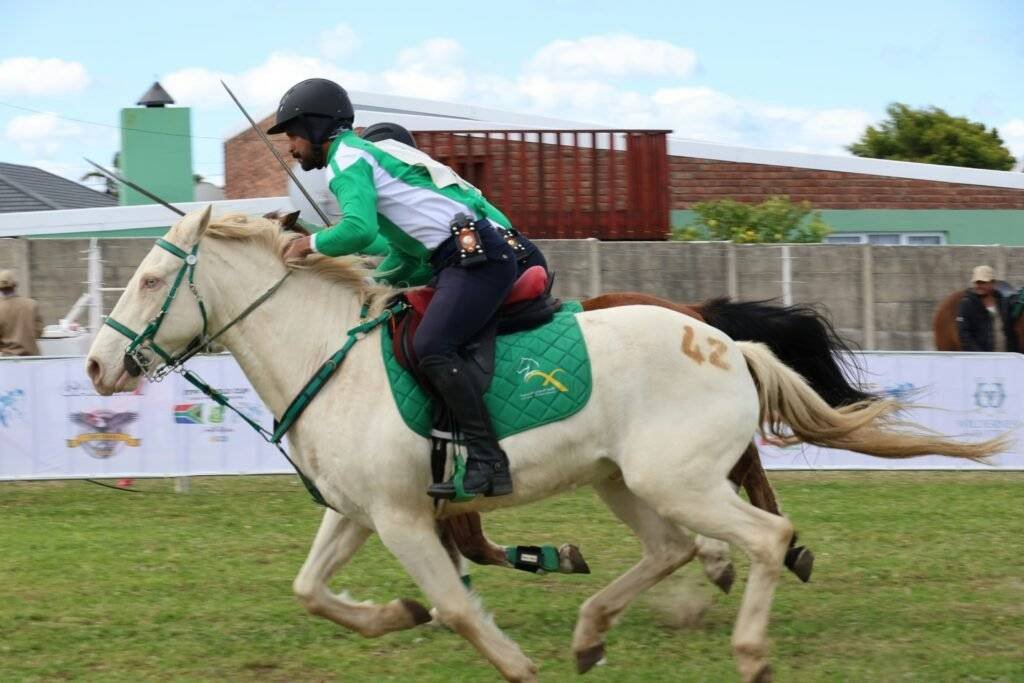
When I first got into racing multiples, this was the bet that finally made sense to me. I wanted the thrill of an acca but I hated walking away with nothing because one favourite got boxed in. A Lucky 15 felt like a fair deal: a sensible spread of risk, plus the chance of a nice payout if more than one horse ended up smashing it.
Calculating Lucky 15 Bets
On paper it sounds simple. In practice the maths snowballs fast. You are dealing with:
- 15 separate bet lines
- fractional or decimal odds
- different place terms for each way
- possible Rule 4 deductions if there is a non‑runner after you take a price
- occasional bookmaker bonuses for one, two, three or four winners
And even more complicated, if you add the two‑part nature of each‑way bets (win part and place part) and even a tidy spreadsheet gets messy. This is exactly why Lucky 15 Calculators exist and why I built one for my own sanity before ever putting it online.
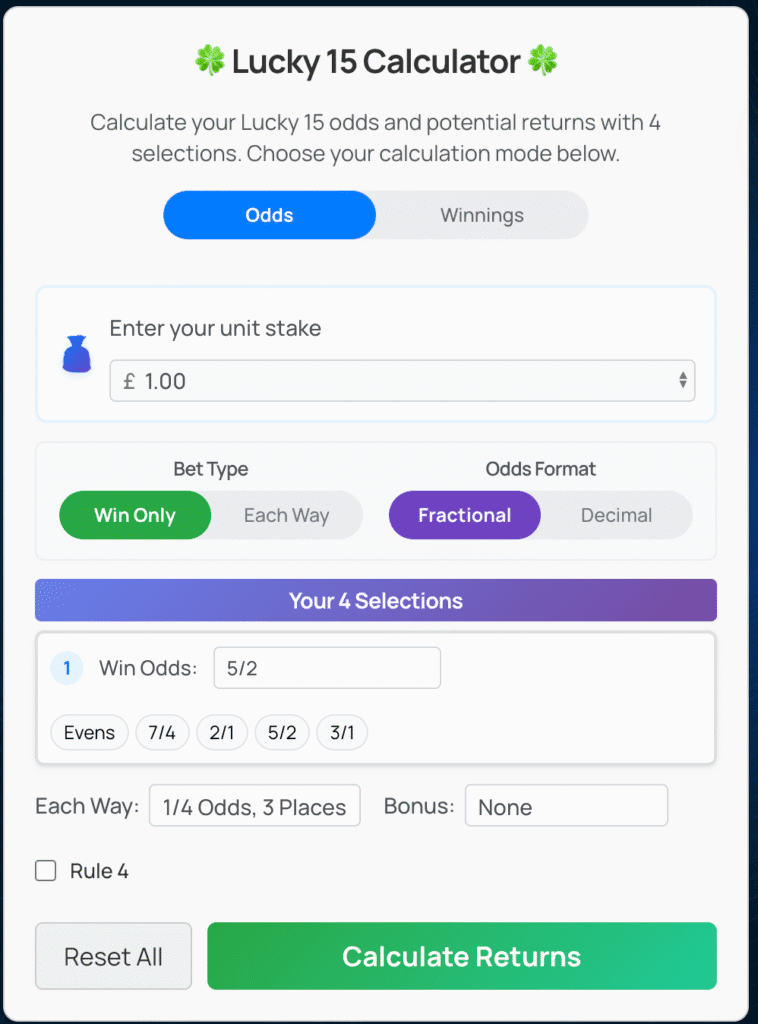
What is a Lucky 15 Each Way Bet?
An each way Lucky 15 bet is where you essentially double up on your 4 selections. You have 4 horses in your Lucky 15 bet and with an each way Lucky 15, you are saying that they will win their races or place.
There is more chance of this bet being ‘right’ but the odds for place are often much lower than odds for winning.
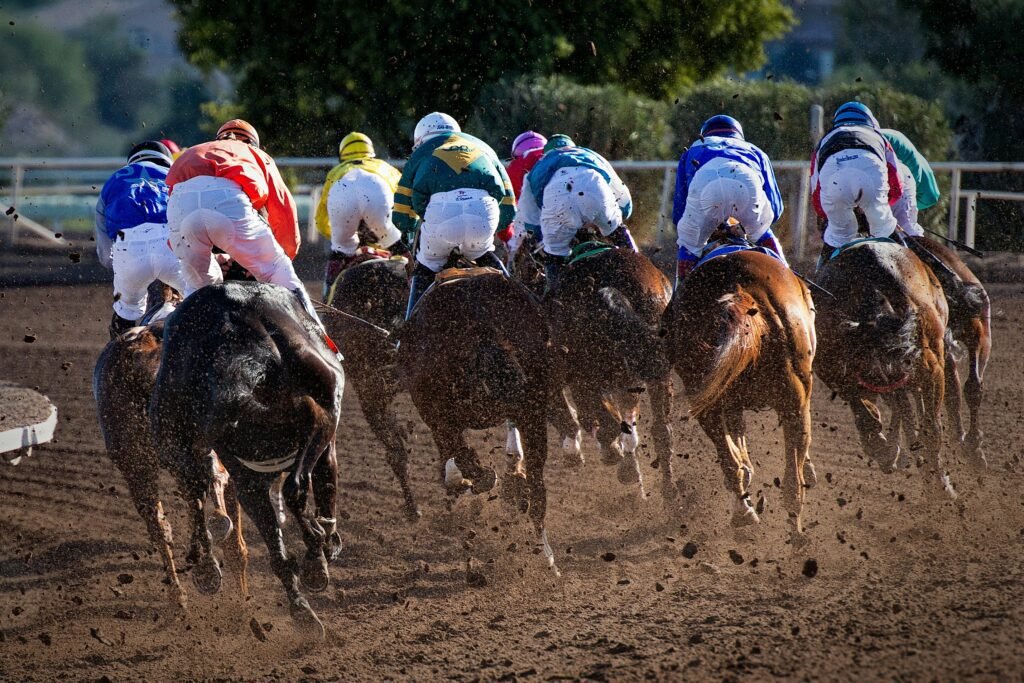
Win‑only Lucky 15 uses a single set of 15 lines across 4 selections. Your stake is divided evenly across the singles, doubles, trebles and the fourfold. You only get paid for lines where every included selection wins.
Each‑way Lucky 15 is effectively two Lucky 15s running in parallel: one at win odds, one at place odds. Your total number of bet lines doubles to 30 and so does the total stake. Winners count as placed on the each‑way side, so a winning selection can feed both the win and the place multiples.
I like each‑way Lucky 15s for big handicaps and racing festivals where the place terms are generous. For sharper midweek cards with short fields, win‑only usually makes more sense.
What are Lucky 15 Place Odds?
Each‑way bets pay out twice when your horse wins: the win part at full odds and the place part at reduced “place odds.” The reduction depends on race type and the number of runners. Typical bookie terms look like this:
- 5 to 7 runners: 1/4 the win odds for 1st and 2nd
- 8+ runners (non‑handicap): 1/5 the win odds for 1st, 2nd, 3rd
- Handicaps 12–15 runners: 1/4 the win odds for 1st, 2nd, 3rd
- Handicaps 16+ runners: 1/4 the win odds for 1st to 4th Promos sometimes extend places further on big days. Always check the race’s place terms before you assume the each‑way math.
To convert this to actual normal numbers – take the win fraction and apply the place fraction.
Example: 10/1 at 1/5 place terms becomes 2/1 for the place part. If you stake £1 on the place portion you’d return £3 (£2 profit plus your £1 stake) when the horse places.
What is a Rule 4 in a Lucky 15?
Rule 4 is a deduction applied to returns when a horse is withdrawn after you’ve taken a Lucky 15 bet and before the race starts. This reduces the payout of your affected betting selections.
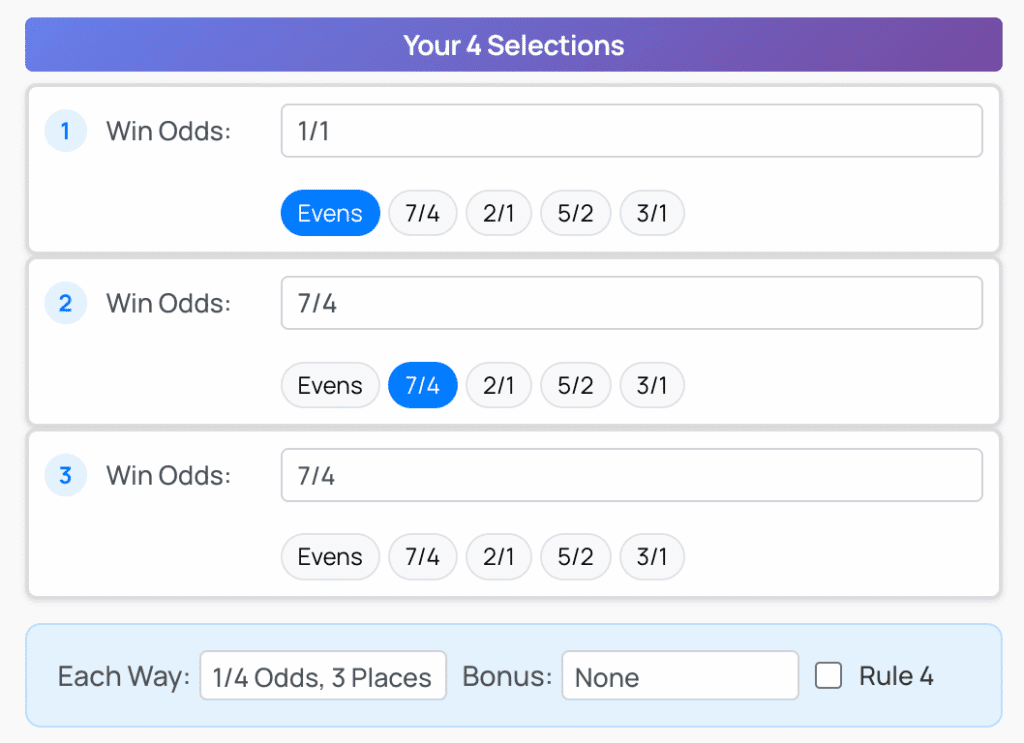
The shorter the withdrawn horse, the bigger the deduction. If there are multiple withdrawals, deductions can stack but are capped by firms at a maximum (commonly 90p in the £). Rule 4 does not increase your stake… it reduces the payout on affected winning lines.
In a Lucky 15 this can hit a lot of lines at once if the withdrawal affects races with your winners or placers. Your singles, doubles, trebles and the fourfold that include the affected race will all settle using the reduced odds.
How Rule 4 plays out in real life
A quick story. I once had a tidy Lucky 15 with two winners in the book and my third, a strong favourite, was scratched at the start. I had taken an early price. The Rule 4 deduction crushed the odds on several of my winning lines. I still made a profit, but it was much thinner than the price tags suggested.
The lesson stuck with me… the earlier you bet, the more you should respect the risk of non‑runners. Calculators and settlement pages will show you the exact deduction for the withdrawn horse’s price band. But mentally, I always shave a little off my excitement if I am on early and the market looks wobbly.
It is another reason I prefer using a Lucky 15 Calculator that applies Rule 4 automatically, because doing it by hand across many lines is brutal.
How a Lucky 15 Works
Let’s lay out the bet clearly… With selections A, B, C, D you have:
- Singles: A, B, C, D
- Doubles: AB, AC, AD, BC, BD, CD
- Trebles: ABC, ABD, ACD, BCD
- Fourfold: ABCD
If you stake £1 per line on a win‑only Lucky 15, your total outlay is £15. On a £1 each‑way Lucky 15, you stake £1 on the 15 win lines and £1 on the 15 place lines for a total of £30.
If you want to skip the examples below, feel free to watch this video, but if you are still none the wiser, check out our detailed examples below.
Example of Win-Only and No Each Way Bets
Suppose the four prices are:
- A at 2/1
- B at 3/1
- C at 5/2
- D at 4/1
Stake £1 per line, total £15.
Only A wins
- Winning lines: A single only
- Return: £1 at 2/1 returns £3
- Profit/loss: £3 return from £15 stake = £12 loss
A and B win
- Winning lines: A single, B single, AB double
- Returns: A single £3; B single £4; AB double at 2/1 × 3/1 = decimal 3.0 × 4.0 = 12.0 so £12
- Total return: £3 + £4 + £12 = £19
- Profit/loss: £4 profit on £15 stake
A, B and C win
- Winning lines: three singles, three doubles (AB, AC, BC) and treble ABC
- Calculate doubles by multiplying decimals: AB 3.0 × 4.0 = 12.0; AC 3.0 × 3.5 = 10.5; BC 4.0 × 3.5 = 14.0
- Treble ABC: 3.0 × 4.0 × 3.5 = 42.0
- Totals: singles £3 + £4 + £3.50 = £10.50; doubles £12 + £10.50 + £14 = £36.50; treble £42
- Total return: £89
- Profit/loss: £74 profit on £15 stake
All four win
- Every line wins: 4 singles, 6 doubles, 4 trebles, the fourfold
- Fourfold ABCD: 3.0 × 4.0 × 3.5 × 5.0 = 210.0; so £210 on that one line alone
- Full payout is the sum of all 15 line returns; the exact number here is less important than the point: the Lucky 15 spreads stake across lots of lines, so your top‑end payout is lower than if you had staked the entire £15 on the fourfold. But you gain resilience on the downside because you are still alive with one or two winners.
This is the trade‑off you are making every time you choose a Lucky 15 over a pure accumulator.
Example: Each‑way Lucky 15 with mixed results
Take this set of prices with standard 1/5 place terms for 3 places:
- A 8/1
- B 6/1
- C 5/1
- D 10/1 Stake a £1 each‑way Lucky 15. That is £15 on the win side and £15 on the place side, total £30.
Assume the results are: A wins, B places, C unplaced, D places.
Win side (15 lines at win odds) Only A actually wins, so on the win side the A single is the only successful line.
- A single return: £1 at 8/1 = £9 back
- All win doubles, trebles and the fourfold need winners only, so they lose because B did not win.
Place side (15 lines at place odds) Winners count as placed. So A, B and D are all placed; C is not. Convert place odds by applying 1/5 to each win fraction:
- A 8/1 → place 8/5 = 1.6/1 → decimal 2.6
- B 6/1 → place 6/5 = 1.2/1 → decimal 2.2
- C 5/1 → place 5/5 = 1/1 → decimal 2.0 (not used as C did not place)
- D 10/1 → place 10/5 = 2/1 → decimal 3.0
Now settle the place side as if it were its own Lucky 15 using those decimals:
- Singles: A 2.6 → £2.60; B 2.2 → £2.20; D 3.0 → £3.00. Singles total £7.80
- Doubles: AB 2.6 × 2.2 = 5.72 → £5.72; AD 2.6 × 3.0 = 7.80 → £7.80; BD 2.2 × 3.0 = 6.60 → £6.60. Doubles total £20.12
- Treble: ABD 2.6 × 2.2 × 3.0 = 17.16 → £17.16
- Fourfold loses because C did not place
Place side return total = £7.80 + £20.12 + £17.16 = £45.08
Grand total
- Win side return: £9.00
- Place side return: £45.08
- Combined return: £54.08 from a £30 total stake → £24.08 profit
That is why each‑way Lucky 15s can be powerful when you expect your selections to run well even if all of them do not win. The place multiples do heavy lifting in exactly this kind of result pattern.
Is a Lucky 15 better than an accumulator?
A Lucky 15 is a type of accumulator that includes singles – so yes, a Lucky 15 is better than an accumulator. An accumulator requires all legs to win for your payout, whereas you can still get a payout from one winner with a Lucky 15.

Accumulator strengths A straight fourfold is simple and cheap to place. Stake £1 and you only have one line to settle. If all four win, the return for that same stake is usually much larger than the return from a £1‑per‑line Lucky 15 because every penny of your stake powers the fourfold. If you had staked the same total £15 on the acca instead of a £1‑per‑line Lucky 15, the top‑end payout is miles higher.
Lucky 15 strengths You buy downside protection. One winner returns something. Two winners often get you back above water. Three winners can put you nicely in front. If you bet for enjoyment and hate the all‑or‑nothing feeling of accas, a Lucky 15 is a better temperament fit.
How I choose When I have four fancy prices and I am swinging for the fences, I still take an acca. When the prices are solid but I fear one weak link, I reach for a Lucky 15. Sometimes I split my stake: a smaller Lucky 15 for ballast and a separate smaller fourfold as a kicker.
Is a Lucky 15 a popular bet?
Very. It is one of the classic “full‑cover” multiples in UK and Irish betting shops, right alongside Lucky 31s and Lucky 63s. It is popular because it effectively offers you downside protection (with the singles).
You can see the popularity of Acca’s vs Lucky 15 bets in the UK over the last 90 days (from June to September 2025) and although it’s not as popular as Acca’s in terms of search volume, it’s a very popular betting term nonetheless!
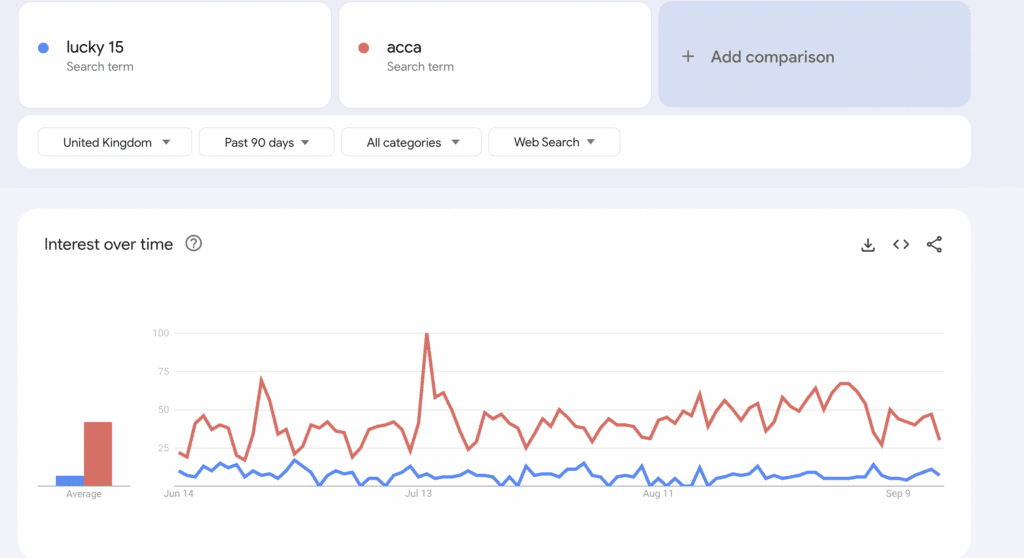
Also, when comparing this alongside the trends in horse racing popularity (see below), you begin to see how resilient Lucky 15 bets are despite changing popularity metrics.
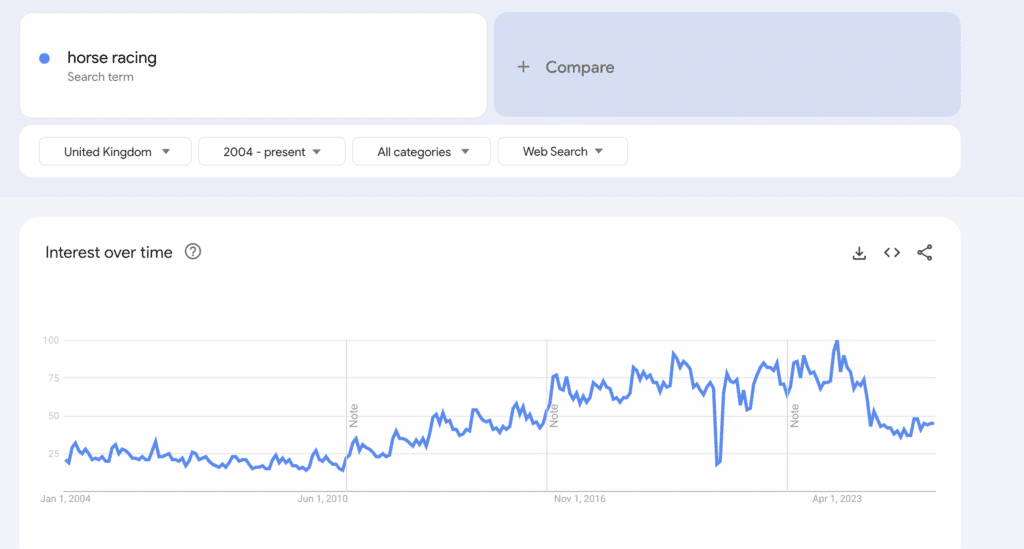
Walk into any shop on a Saturday and you will see punters writing Lucky 15s on the slips. Online it is just as common because most sportsbooks surface it as a quick‑pick option in the multiples tab.
How is a Lucky 15 different to a Lucky 31 or Lucky 63?
The “Lucky” family grows by adding selections and therefore lines.
- Lucky 15: 4 selections, 15 lines (4 singles, 6 doubles, 4 trebles, 1 fourfold)
- Lucky 31: 5 selections, 31 lines (5 singles, 10 doubles, 10 trebles, 5 fourfolds, 1 fivefold)
- Lucky 63: 6 selections, 63 lines (6 singles, 15 doubles, 20 trebles, 15 fourfolds, 6 fivefolds, 1 sixfold)
Because the number of lines grows fast, your total stake grows too. A £1 win‑only Lucky 63 costs £63; a £1 each‑way Lucky 63 costs £126. The principle is exactly the same, you just have more combinations firing if your runners oblige.
What are bookmaker bonuses on Lucky 15s?

Many bookies offer sweeteners on Lucky 15s, especially on horse racing. The two common ones are:
- A boost if you get just one winner (e.g. a one‑winner bonus)
- A bonus if you land all four winners (sometimes a percentage uplift)
The exact terms vary by bookmaker and by promotion. Some apply only to horses; some exclude each‑way. Do not bank on a bonus without checking the day’s terms. I treat any bonus as an unexpected extra, not part of the expected return.
How to Calculate a Lucky 15 By Hand
If you ever (for some wild reason!) want to check a result yourself by hand, this is the basic process I follow:

- Convert fractions to decimals including the stake. For example 8/1 becomes 9.0 decimal; 7/2 becomes 4.5 decimal.
- For each winning line, multiply the relevant decimals. A double at 3.0 and 4.0 returns 12.0 times the stake on that line.
- Add every winning line across the singles, doubles, trebles and the fourfold.
- For each‑way, repeat the process using place odds, remembering winners are counted as placed.
- Apply any Rule 4 reduction to the affected lines only.
- Finally, subtract your total stake to see profit.
Do this once and you will immediately see why using a calculator is a better option!
Mistakes I see with Lucky 15s
- People confuse total stake: A £1 each‑way Lucky 15 is £30, not £15. You are staking on 30 lines in total (win and place…)
- Forgetting winners are placed: On the each‑way side, a winning horse feeds the place multiples too.
- Ignoring place terms: 1/4 vs 1/5 place terms make a bigger difference than people think, especially on doubles and trebles.
- Overestimating bonuses: They are not guaranteed and not universal. Treat them as nice surprises.
- Not accounting for Rule 4: Early prices carry non‑runner risk. Late withdrawals can clip your returns.
Is there a best way to pick four for a Lucky 15?
No magic. I build my Lucky 15s with a mix of confidence and price. If I have two shorties I really trust and two value outsiders with place chances, an each‑way Lucky 15 can be a fun way to express that view. If my four are all chalk, I either reduce stakes or go win‑only to avoid diluting returns on the each‑way side.
I also try not to chain selections that are overly correlated unless I want that effect. For example, two front‑runners on the same track in the same conditions may be more linked than I think. Variety of race type and trip can keep your bet alive through changing race shapes.
Quick FAQ
Is a Lucky 15 only for horse racing? No. The structure works for greyhounds and other sports with standalone events. Horse racing is just where it is most common.
Can I cash out a Lucky 15? Many firms allow partial or full cash out once some legs have settled, but availability and pricing vary.
Do SP bets get hit by Rule 4? Usually Rule 4 applies when you have taken a fixed price. Some firms may apply a deduction to SPs for very late withdrawals. Check the rules section of your bookmaker.
What happens with a dead heat? Returns for the affected lines are adjusted according to the firm’s dead‑heat rules. A calculator that supports dead‑heat inputs saves serious head‑scratching here.
Summary
A Lucky 15 is the working punter’s multi. It keeps you in the game if one or two let you down, and it can still pay handsomely when your form is hot. It is not “better” than an accumulator; it is different. The stake is wider, the ride lasts longer, and the maths is heavier. If you are the kind of person who likes to understand exactly where your money is going, get comfortable with the structure and use a calculator to do the grunt work. That combination of clarity and discipline has made my Saturdays far more enjoyable.
James is an experienced Lucky 15 bettor having bet avidly on horse racing & on tracks across the UK for over 25 years. His expertise lies in building amazing calculator tools for UK consumers and is the leading expert in Lucky 15's both online and in-shop.
Peter is an award-winning horse racing sports writer and avid equestrian. He has 10+ years in sports journalism & Lucky 15 betting. He is an active writer for some of the leading sports news outlets worldwide including horse racing & betting / igaming. His current role is as Founder of Lucky 15 Calculator. He lives in Oxfordshire with his wife and two children.
